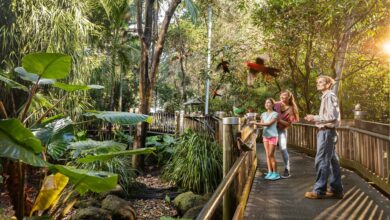
James Hilyard is Ipswich City Council’s Infrastructure and Environment Department, City Maintenance manager.
James is a horticulturalist, arborist and holds a master’s degree in sustainability.
In this month’s column, James talks about how to select and plant trees.
Spring has sprung and any keen gardener will be surveying their patch looking for an opportunity to fill any gaps with something special, maybe a tree of some description.
Trees help clean the air we breathe, filter the water we drink, and provide habitat to over 80 per cent of the world’s biodiversity.
They also provide shade to the garden and reprieve from the heat coming our way and if you chose one that produces fruit or nuts, they will feed you as well.
Selecting a tree for your garden can be very daunting, lots of choices.
Evergreen, deciduous, native or ornamental there are lots things to consider and generally there is a tree somewhere for every situation.
The most important aspect of any selection is probably the one most overlooked -how big will it grow?
Most tree tags will have some information on height and spread as well as a pretty picture but this is usually only a guide as there are many factors that will determine how big a tree will grow.
How much sun, water and the amount of nutrients available to the tree throughout its life will greatly affect the speed of growth and generally determine if it will reach its full potential.
The quality and preparation of the soil the tree is planted into is critical, much better to do the work up front rather than try to add nutrients at a later date.

Tips before you buy and select a tree for your garden
- Look up: When you choose where you want to plant your tree look up to see if there are powerlines above you.
- Look down: If you are going to be digging a hole to plant a decent size tree get a ‘dial before you dig’ clearance before you start work. Nothing like getting the fire brigade out to your house because you have hit a gas line when trying to plant your new Frangipani.
- Prepare your soil, dig a hole twice the size of the root ball of the tree and add some aged compost and mix it well with the existing soil.
- Water the pot well before you remove the tree from its container making sure all the roots are well soaked and ready for transplant shock.
- Avoid the middle of the day. Late afternoon when the temperature starts to drop is best or early morning, try to avoid a hot, dry and windy day for planting. Always best to plant on a cool cloudy or even better rainy day.
- Select good stock. Avoid trees grown with a single stake and a long thin trunk. These trees have been pushed along to grow tall as quickly as possible and are not strong and robust. Always try to find a tree that is thicker at the base of the trunk rather than a tree that has uniform trunk thickness.
- If a tree has a single stake, remove it before planting. If you are a patient person you can leave the tree in a cool protected area for a few weeks for it to harden up before planting. If you are like me and not patient you can plant it out but use two or three stakes to support the tree if it’s unable to stand up on its own. Use tree ties that will allow the tree some movement when the wind blows, this will allow for a strong root system to develop that will anchor the tree without support.
- Match your selection with the location. Planting a tree that cannot handle full sun on an exposed western side of a site will probably result in another trip to the nursery.
- Walk around your garden at about 2pm and you will see where the hotspots are and where there is shelter. As a general rule native plants like full sun and can handle dry conditions better than most introduced species so consider some fast growing acacia species that can act as a protective barrier for some less hardy specimens.
The staff at Ipswich City Council’s nursery can help you choose plants that are right for your garden and some native species of trees are best grown from tube stock and will often out grow larger plants planted at the same time.
Our plant giveaway program is proving very popular this spring so drop on in and our friendly knowledgeable staff are happy to help point you in the right direction.
General homeowners and renters are entitled to six free plants each financial year under council’s Free Plant Program.
These can be collected from Queens Park nursery or any of the mobile nurseries.



